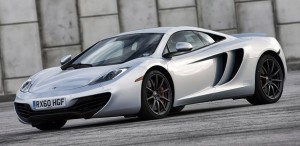Top 3 Fastest Hypercars
For some, only the most extreme will do. Hypercars are for these people. A hypercar may never even travel at half its ultimate speed – but the knowledge that it can do it is enough. The trick for the makers is to make sure they can do it… and get a place in the record books to prove it.
Such cars cannot be developed like normal models. Road cars have a diverse set of requirements, and even fast Ferraris must also carry luggage, have long service intervals and be easy to drive in city centres. Not so for hypercars. There, the main focus is top speed, with every engineering decision being made with this in mind.
It’s why the cars are so very different to all others – and this is what people are so keen to buy into. Every component, every suspension change, even the spec of the glass in the windows has been made to help achieve that top speed.
Cars are usually built by smaller companies, often highly specialised unknowns. The market for these models is limited and big-brand makers struggle to make a business case for them. The compromises that very high top speeds impose make the models less useable in daily conditions than the more rounded supercars – hypercars really are just that.
15 years ago, 200mph was a massive, headline-grabbing deal. Today, well in excess of 250 miles per hour is a prerequisite. Future cars must have 300mph as a target. Such a high speed will require big developments in technologies such as tyres and brakes, driveshafts and wheel bearings, even body materials that have to deal with such aerodynamic loads. But relentless progress means they’ll come.
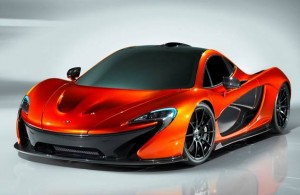 Visually, hypercars are unmistakable. They contrast with cars built for handling, which generate downforce to keep them stuck to the ground in corners. This is why Formula 1 cars have huge rear wings, for example. If speed is a priority, these wings become surplus: getting a low aerodynamic drag factor is vital. This is the coefficient of drag (Cd). As such, hypercars generally have smooth surfaces and gently rounded edges for good Cd figures: picture the profile of a water drop. This is also why they often have long but sharply cut-off tails: the ‘wake’ of air must be as small as physically possible.
Visually, hypercars are unmistakable. They contrast with cars built for handling, which generate downforce to keep them stuck to the ground in corners. This is why Formula 1 cars have huge rear wings, for example. If speed is a priority, these wings become surplus: getting a low aerodynamic drag factor is vital. This is the coefficient of drag (Cd). As such, hypercars generally have smooth surfaces and gently rounded edges for good Cd figures: picture the profile of a water drop. This is also why they often have long but sharply cut-off tails: the ‘wake’ of air must be as small as physically possible.
Similarly, the frontal area should be minimised, which means getting it low to the ground. The air drag index is actually a function of Cd and frontal area: if both are low, the car will be very aerodynamic – but even a low and lean front end won’t make a car sleek if the rest of it hasn’t been thought through properly.
Impressive power is essential. Whereas road cars have power figures in the hundreds, hypercars measure output in the thousands. It is virtually a prerequisite for a 2gomph car to have more than 1,000 horsepower: so quickly do loads rise at speed, big increases in output are needed for apparently minor jumps in top speed.
Hyper top speeds are actually a function of three variables – engine power, air resistance and rolling resistance. This is why many land speed record cars have such skinny tyres. These are completely unrealistic for road use, where cars also have to corner – hence the focus on power and aerodynamics.
Tyres carry huge loads: bespoke land speed tyres must be fitted, as road going tyres simply can’t cope. Pressures are often very high – a Bugatti Veyron Super Sport has inflation pressures of 43psi, compared with 3opsi of a Ford Fiesta.
Official rules for the ultimate world land speed record state a fixed length course must be used. Two runs must be made, in opposite directions, within an hour. The speed is taken as the average of the two.
No such official test exists for production cars, though. Some claims are therefore dubious: the most valid are claims verified by independent testers such as Guinness World Records. Along with German independent body TUV, it verified the Bugatti Super Sport top speed, from an average of three runs.
SSC Ultimate Aero
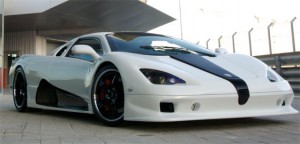 SSC is an American company that has long punched well above its weight. Despite being a relative unknown, it has taken on all corners in the hypercar arena – and, until recently, won through. Till the Bugatti Veyron Super Sport beat it, the Ultimate Aero was officially the world’s fastest car.
SSC is an American company that has long punched well above its weight. Despite being a relative unknown, it has taken on all corners in the hypercar arena – and, until recently, won through. Till the Bugatti Veyron Super Sport beat it, the Ultimate Aero was officially the world’s fastest car.
Its shape was developed and tested in NASA’s full-size wind tunnel at Langley, Virginia. This was to ensure the car would be aerodynamically stable at high speeds before they were actually reached. Six NASA scientists worked with the SSC team to hone the Ultimate Aero’s surfaces: the challenge was to make it smooth through the air, without creating dangerous lift at either end of the vehicle.
Braking from high speed is helped by an AeroBrake rear spoiler. This pops up by up to eight inches, depending on how hard the brake pedal is pushed, but remains tucked away when not needed to minimise drag.
The follow-up Ultimate Aero II has one-piece carbon fibre wheels. SSC engineers say these are half the weight of regular forged alloy wheels, and are stiffer too. Reduced unsprung masses improves handling and stability, particularly at high speed where the already-loaded suspension can be less unsettled by sudden road impacts.
The V8 engine is made from a single piece of billet aluminium. This is stronger than cast aluminium so it can be tuned more strongly. It also helps produce more power because the cylinders are ‘truer’ – there is a better ring seal with such tight tolerances, meaning less leakage of combustion gases and a bigger ‘bang’ transmitted to the road wheels.
Because the Ultimate Aero is sold in the United States, it requires road car legislation certificates, including emissions. SSC has even achieved California Smog Certification, which is an extremely strict test that places tight limits on exhaust gas emissions.
On-board diagnostics are provided by an Azentek PC-based monitor. This keeps track of the car’s systems and also provides the full capability of a PC, meaning it is flexible and adaptable by laptop-wielding car technicians.
SSC Ultimate Aero facts
Chip off the block – The engine block is made from a forged billet of aluminium, instead of cast aluminium. Tensile strength improves by a third, yield strength by two thirds – and it’s lighter as well.
Monster gearing – A six-speed gearbox and a 272mph top speed means huge speed in other gears: 8imph in 2nd, 117mph in 3rd, 155mph in 4th – and more than 200mph in 5th.
A mile in half a minute – From a standing start, the Aero can cover a quarter-mile in just 9.9 seconds. It will then be covering 144mph, illustrating just how fast it is.
Ultimate tyres – Michelin PS2 tyres are rated for ultra-high top speeds. They are also used on the Bugatti Veyron and other hypercars.
Big brakes – Incredible speed needs incredible brakes. The SSC has 14-inch vented discs, with slots, grabbed by eight-piston callipers up front. Normal cars have two-piston callipers.
More than its weight – Around a constant circle, the SSC generates up to 1.05g in cornering force. So it weighs more in hard cornering than it does at rest.
Carbon fibre cool – Additional carbon fibre louvers on the side of the latest Aero improve airflow to radiators by 20 per cent. This provides adequate cooling to the engine.
Veyron Super Sport
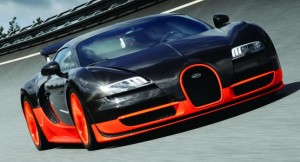 The Bugatti Veyron Super Sport is the car Top Gear proved to be the world’s fastest. Presenter James May flew to a test track in Germany and drove it 253mph. Earlier, a Bugatti test driver took it up to 268mph -independently verified and therefore creating new land speed world record. Allegedly, the record-breaking top speed took even the engineers by surprise-they were expecting 264mph. So how did it do it? Mainly thanks to a lot more power.
The Bugatti Veyron Super Sport is the car Top Gear proved to be the world’s fastest. Presenter James May flew to a test track in Germany and drove it 253mph. Earlier, a Bugatti test driver took it up to 268mph -independently verified and therefore creating new land speed world record. Allegedly, the record-breaking top speed took even the engineers by surprise-they were expecting 264mph. So how did it do it? Mainly thanks to a lot more power.
The Super Sport puts out 1,200bhp thanks to four larger turbochargers than the standard model, fed by four larger intercoolers. They supply charged air to an 8.o-litre mid-mounted Wi6 engine. As it is – on a basic level, two V8 engines paired together – it is relatively compact for such a large 16-cylinder engine: it’s 710mm long and 767mm wide.
The engine is fed air from two NACA ducts located in the roof. These are named after the National Advisory Committee for Aeronautics, and are low drag due to the extremely smooth shape. They generate tiny vortices, which deflect the boundary layer of slow-moving air clinging to the car’s body – this allows in the faster-moving air, so a far greater quantity of air is ingested.
Aerodynamics have been revised. The front intakes have been reshaped and there’s a double diffuser at the rear: exhausts are central for rear-end stability. The body is smoother-the NACA ducts sit flush, instead of the standard Veyron’s stick-up intake ducts, so there’s less drag and air disturbance. The car weighs oven.8 tons, but weight is not vital to top speed. But it is for acceleration: imagine how quick off the line the Bugatti would be if it were lighter.
Veyron Super Sport facts
Suspension descends – Height-adjusting suspension runs 115mm front and rear in normal use. For top speed, this reduces to 65mm at the front and 70mm at the rear.
Adjustable wing – The angle of the rear wing adjusts according to use. For top speed it’s three degrees, rising to 55 degrees to brake for maximum retardation.
0.1-second gearchanges – The seven-speed gearbox uses twin clutches, to which alternate gear sets are connected. This ensures no breaks in gearchanges.
High-tech carbon – Bugatti introduced a new carbon fibre structure for the Super Sport monocoque. This is more rigid, safe, and light.
Limited top speed – Bugatti limits the road car top speed to 257mph to protect the tyres. The Super Sport available to buy will otherwise be identical to the268mph record breaker.
Speedy – Accelerating from a standing start, the Veyron will cover a whole mile just 23.6 seconds later.
Dagger GT
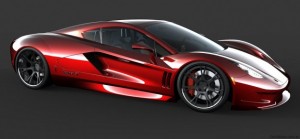 The Dagger designers are not using the latest technology to achieve awesome top speeds. Instead, they’re using proven engineering solutions and decades of land speed and NASA experience. Five versions of the Dagger are available. The 300mph car will be a bespoke Dagger GT-LS version, with a one-inch ride height, roll cage, drag chutes and 450kg of front ballast (for high-speed safety, it will keep the front of the GT-LS on the ground). The engine will be so highly tuned, it won’t be suitable for road use.
The Dagger designers are not using the latest technology to achieve awesome top speeds. Instead, they’re using proven engineering solutions and decades of land speed and NASA experience. Five versions of the Dagger are available. The 300mph car will be a bespoke Dagger GT-LS version, with a one-inch ride height, roll cage, drag chutes and 450kg of front ballast (for high-speed safety, it will keep the front of the GT-LS on the ground). The engine will be so highly tuned, it won’t be suitable for road use.
Horsepower is key to high top speeds – that, and good aerodynamics. TranStar used a NASA aerodynamicist, who discovered that the shape of the GT, including 1.95m2 frontal area and 0.28 Cd, will allow 300mph… if it also has 2,000bhp. So, that’s what it has, via a petrol-methanol, twin-turbo 572 cubic inch V8 engine. There are dual fuel injectors for each cylinder – at 300mph, the dual fuel tanks will empty in six minutes. TranStar says that, for ‘a little insurance’, it can offer up to 2,500bhp. A special custom-made six-speed gearbox has also been designed to deal with such high horsepower.
TranStar says there are good aerodynamic reasons why supercars have not exceeded 300mph: “This is the danger zone and you must take precautions before attempting these speeds. We have the horsepower, aerodynamics and the engineering know-how. It can be done mathematically, on paper. And we have the guys who can make it reality.”
Dagger GT facts
Deploy the chute – It’s common practice for world speed record cars to have a rear parachute for rapid braking.
Big bore engine – Each cylinder in the engine is ‘square’ in dimensions -114mm bore and 114mm stroke.
Quarter mile hurricane – The benchmark quarter-mile from a standing start is estimated to take 6.6 seconds.
All torque – TranStar is aiming for 2,000lb-ft of torque from the engine. Such pulling power will provide massive response to the throttle.
Clutch can cope – The huge clutch is made up of three friction plate discs. It is rated to 2,500bhp.
![McLaren MP4-12C McLaren MP4-12C]() Top 3 NEW hypercars
Top 3 NEW hypercars
1. McLaren MP4-12C – The MP4-12C uses an Fl-style carbon fibre tub that weighs just 80kg around which the high-tech car is constructed.
2. Aston Martin One-77 – The One-77 is an all-carbon fibre monocoque model powered by a 7.3-litre V12 engine producing 750bhp. Max speed over 220 mph.
3. Pagani Huayra – 6.0-litre V12 Mercedes twin-turbo engine put out 730bhp, and clever aerodynamics give it a top speed of 230mph.


